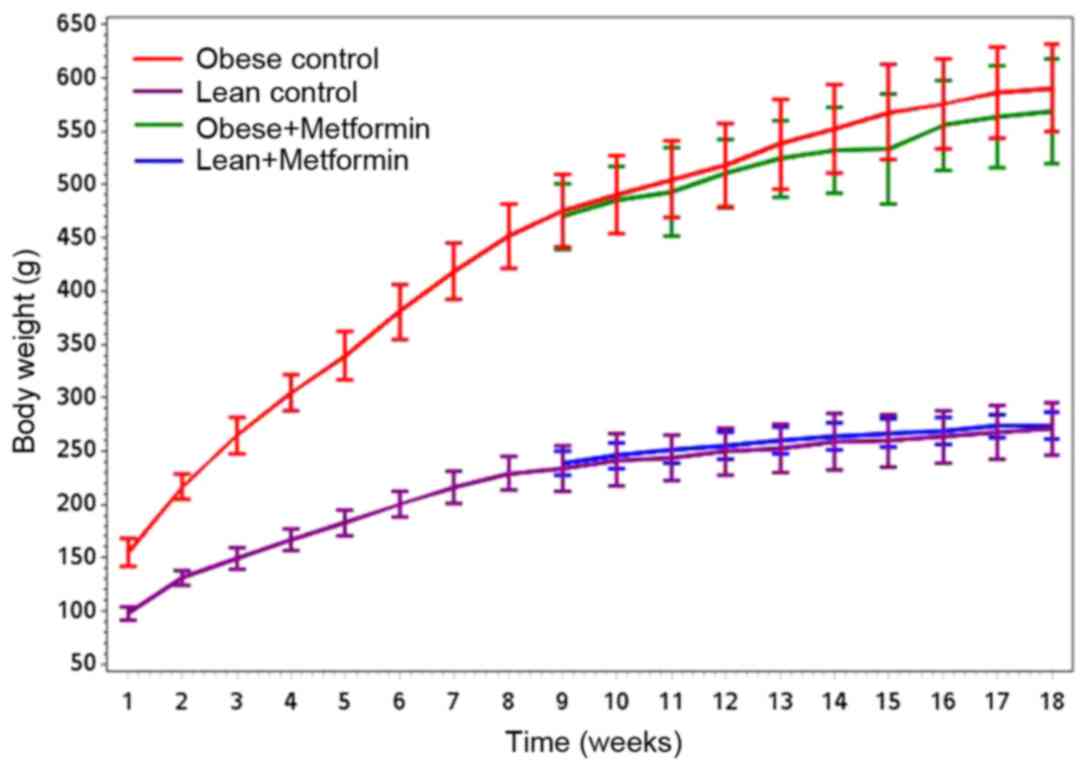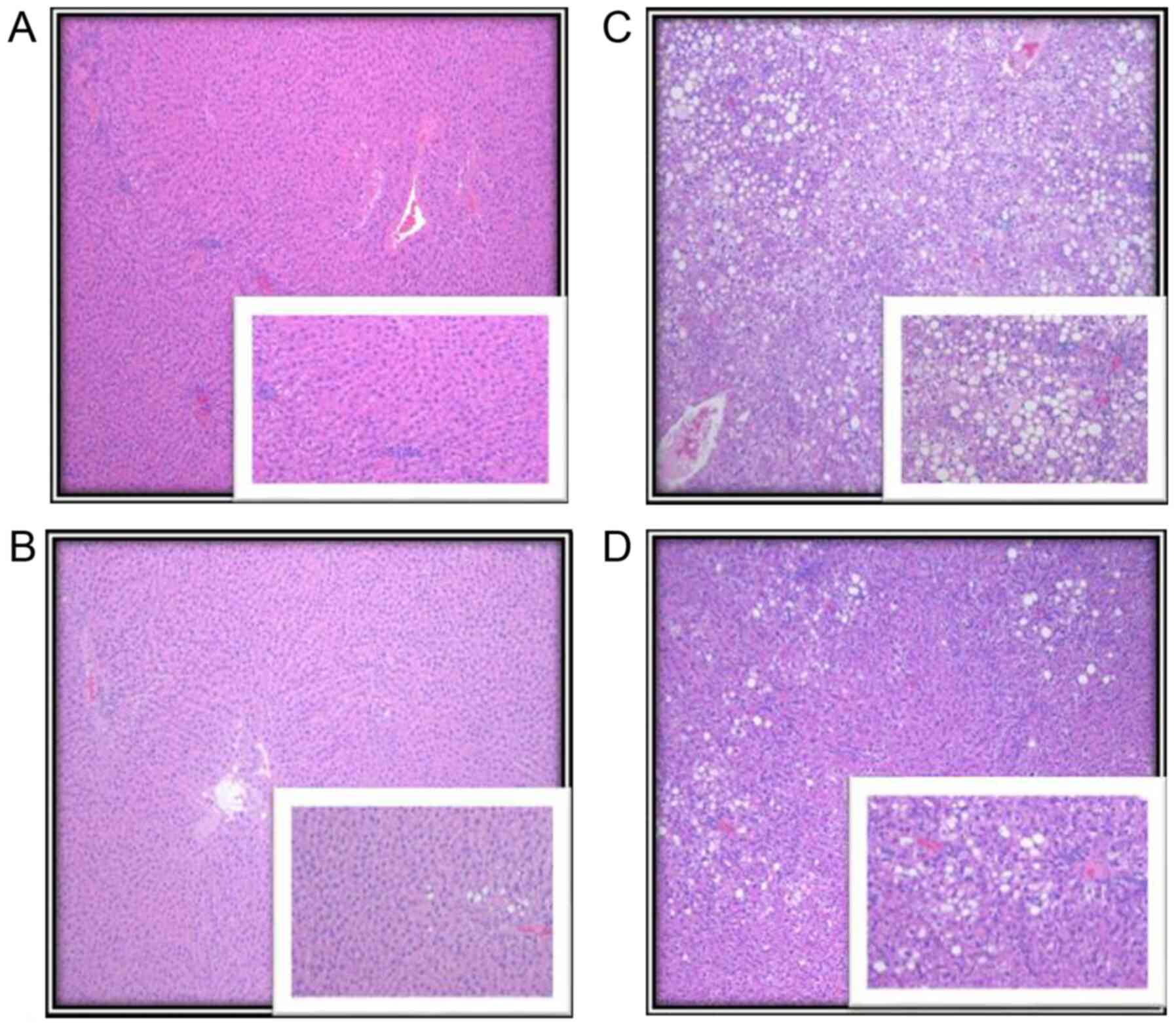|
1
|
Centers for Disease Control and
Prevention: Adult Obesity Facts. CDC, 2020.
|
|
2
|
World Health Oraganization: Overweight and
obesity. WHO, 2020.
|
|
3
|
Ogden CL, Carroll MD, Curtin LR, Lamb MM
and Flegal KM: Prevalence of high body mass index in US children
and adolescents, 2007-2008. JAMA. 303:242–249. 2010.PubMed/NCBI View Article : Google Scholar
|
|
4
|
Ogden CL, Carroll MD, Lawman HG, Fryar CD,
Kruszon-Moran D, Kit BK and Flegal KM: Trends in obesity prevalence
among children and adolescents in the United States, 1988-1994
through 2013-2014. JAMA. 315:2292–2299. 2016.PubMed/NCBI View Article : Google Scholar
|
|
5
|
Lazo M, Hernaez R, Eberhardt MS, Bonekamp
S, Kamel I, Guallar E, Koteish A, Brancati FL and Clark JM:
Prevalence of nonalcoholic fatty liver disease in the United
States: The Third National Health and Nutrition Examination Survey,
1988-1994. Am J Epidemiol. 178:38–45. 2013.PubMed/NCBI View Article : Google Scholar
|
|
6
|
Angulo P: GI epidemiology: Nonalcoholic
fatty liver disease. Aliment Pharmacol Ther. 25:883–889.
2007.PubMed/NCBI View Article : Google Scholar
|
|
7
|
Welsh JA, Karpen S and Vos MB: Increasing
prevalence of nonalcoholic fatty liver disease among United States
adolescents, 1988-1994 to 2007-2010. J Pediatr. 162:496–500.e1.
2013.PubMed/NCBI View Article : Google Scholar
|
|
8
|
Hakkak R, Al-Dwairi A, Fuchs GJ, Korourian
S and Simmen FA: Dietary soy protein induces hepatic lipogenic
enzyme gene expression while suppressing hepatosteatosis in obese
female Zucker rats bearing DMBA-initiated mammary tumors. Genes
Nutr. 7:549–558. 2012.PubMed/NCBI View Article : Google Scholar
|
|
9
|
Hakkak R, Zeng H, Dhakal IB and Korourian
S: Short- and long-term soy diet versus casein protects liver
steatosis independent of the arginine content. J Med Food.
18:1274–1280. 2015.PubMed/NCBI View Article : Google Scholar
|
|
10
|
Thomas I and Gregg B: Metformin; a review
of its history and future: From lilac to longevity. Pediatr
Diabetes. 18:10–16. 2017.PubMed/NCBI View Article : Google Scholar
|
|
11
|
Khokhar A, Umpaichitra V, Chin VL and
Perez-Colon S: Metformin use in children and adolescents with
prediabetes. Pediatr Clin North Am. 64:1341–1353. 2017.PubMed/NCBI View Article : Google Scholar
|
|
12
|
Luong DQ, Oster R and Ashraf AP: Metformin
treatment improves weight and dyslipidemia in children with
metabolic syndrome. J Pediatr Endocrinol Metab. 28:649–655.
2015.PubMed/NCBI View Article : Google Scholar
|
|
13
|
Madiraju AK, Qiu Y, Perry RJ, Rahimi Y,
Zhang XM, Zhang D, Camporez JG, Cline GW, Butrico GM, Kemp BE, et
al: Metformin inhibits gluconeogenesis via a redox-dependent
mechanism in vivo. Nat Med. 24:1384–1394. 2018.PubMed/NCBI View Article : Google Scholar
|
|
14
|
Lin HZ, Yang SQ, Chuckaree C, Kuhajda F,
Ronnet G and Diehl AM: Metformin reverses fatty liver disease in
obese, leptin-deficient mice. Nat Med. 6:998–1003. 2000.PubMed/NCBI View
Article : Google Scholar
|
|
15
|
Marchesini G, Brizi M, Bianchi G,
Tomassetti S, Zoli M and Melchionda N: Metformin in non-alcoholic
steatohepatitis. Lancet. 358:893–894. 2001.PubMed/NCBI View Article : Google Scholar
|
|
16
|
Xu H, Zhou Y, Liu Y, Ping J, Shou Q, Chen
F and Ruo R: Metformin improves hepatic IRS2/PI3K/Akt signaling in
insulin-resistant rats of NASH and cirrhosis. J Endocrinol.
229:133–144. 2016.PubMed/NCBI View Article : Google Scholar
|
|
17
|
Tiikkainen M, Häkkinen AM, Korsheninnikova
E, Nyman T, Mäkimattila S and Yki-Järvinen H: Effects of
rosiglitazone and metformin on liver fat content, hepatic insulin
resistance, insulin clearance, and gene expression in adipose
tissue in patients with type 2 diabetes. Diabetes. 53:2169–2176.
2004.PubMed/NCBI View Article : Google Scholar
|
|
18
|
Nair S, Diehl AM, Wiseman M, Farr GH Jr
and Perrillo RP: Metformin in the treatment of non-alcoholic
steatohepatitis: A pilot open label trial. Aliment Pharmacol Ther.
20:23–28. 2004.PubMed/NCBI View Article : Google Scholar
|
|
19
|
Lavine JE, Schwimmer JB, Van Natta ML,
Molleston JP, Murray KF, Rosenthal P, Abrams SH, Scheimann AO,
Sanyal AJ, Chalasani N, et al: Nonalcoholic Steatohepatitis
Clinical Research Network: Effect of vitamin E or metformin for
treatment of nonalcoholic fatty liver disease in children and
adolescents: The TONIC randomized controlled trial. JAMA.
305:1659–1668. 2011.PubMed/NCBI View Article : Google Scholar
|
|
20
|
Labruna G, Pasanisi F, Nardelli C, Caso R,
Vitale DF, Contaldo F and Sacchetti L: High leptin/adiponectin
ratio and serum triglycerides are associated with an ‘at-risk’
phenotype in young severely obese patients. Obesity (Silver
Spring). 19:1492–1496. 2011.PubMed/NCBI View Article : Google Scholar
|
|
21
|
Korourian S, Hakkak R, Ronis MJJ, Shelnutt
SR, Waldron J, Ingelman-Sundberg M and Badger TM: Diet and risk of
ethanol-induced hepatotoxicity: Carbohydrate-fat relationships in
rats. Toxicol Sci. 47:110–117. 1999.PubMed/NCBI View Article : Google Scholar
|
|
22
|
Zucker LM: Fat mobilization in vitro and
in vivo in the genetically obese Zucker rat ‘fatty’. J Lipid Res.
13:234–243. 1972.PubMed/NCBI
|
|
23
|
Zucker LM and Zucker TF: Fatty, a new
mutation in the rat. J Hered. 52:275–278. 1961.
|
|
24
|
Hakkak R, Gauss CH, Bell A and Korourian
S: Short-term soy protein isolate feeding prevents liver steatosis
and reduces serum ALT and AST levels in obese female zucker rats.
Biomedicines. 6(6)2018.PubMed/NCBI View Article : Google Scholar
|
|
25
|
Zheng J, Woo SL, Hu X, Botchlett R, Chen
L, Huo Y and Wu C: Metformin and metabolic diseases: A focus on
hepatic aspects. Front Med. 9:173–186. 2015.PubMed/NCBI View Article : Google Scholar
|
|
26
|
Lu CH, Hung YJ and Hsieh PS: Additional
effect of metformin and celecoxib against lipid dysregulation and
adipose tissue inflammation in high-fat fed rats with insulin
resistance and fatty liver. Eur J Pharmacol. 789:60–67.
2016.PubMed/NCBI View Article : Google Scholar
|
|
27
|
Srinivasan S, Ambler GR, Baur LA, Garnett
SP, Tepsa M, Yap F, Ward GM and Cowell CT: Randomized, controlled
trial of metformin for obesity and insulin resistance in children
and adolescents: Improvement in body composition and fasting
insulin. J Clin Endocrinol Metab. 91:2074–2080. 2006.PubMed/NCBI View Article : Google Scholar
|
|
28
|
Love-Osborne K, Sheeder J and Zeitler P:
Addition of metformin to a lifestyle modification program in
adolescents with insulin resistance. J Pediatr. 152:817–822.
2008.PubMed/NCBI View Article : Google Scholar
|
|
29
|
Burgert TS, Duran EJ, Goldberg-Gell R,
Dziura J, Yeckel CW, Katz S, Tamborlane WV and Caprio S: Short-term
metabolic and cardiovascular effects of metformin in markedly obese
adolescents with normal glucose tolerance. Pediatr Diabetes.
9:567–576. 2008.PubMed/NCBI View Article : Google Scholar
|
|
30
|
Wilson DM, Abrams SH, Aye T, Lee PD,
Lenders C, Lustig RH, Osganian SV and Feldman HA: Glaser Pediatric
Research Network Obesity Study Group. Metformin extended release
treatment of adolescent obesity: A 48-week randomized,
double-blind, placebo-controlled trial with 48-week follow-up. Arch
Pediatr Adolesc Med. 164:116–123. 2010.PubMed/NCBI View Article : Google Scholar
|
|
31
|
Kay JP, Alemzadeh R, Langley G, D'Angelo
L, Smith P and Holshouser S: Beneficial effects of metformin in
normoglycemic morbidly obese adolescents. Metabolism. 50:1457–1461.
2001.PubMed/NCBI View Article : Google Scholar
|
|
32
|
Atabek ME and Pirgon O: Use of metformin
in obese adolescents with hyperinsulinemia: A 6-month, randomized,
double-blind, placebo-controlled clinical trial. J Pediatr
Endocrinol Metab. 21:339–348. 2008.PubMed/NCBI View Article : Google Scholar
|
|
33
|
El-Lakkany NM, Seif El-Din SH, Sabra AA,
Hammam OA and Ebeid FA: Co-administration of metformin and
N-acetylcysteine with dietary control improves the biochemical and
histological manifestations in rats with non-alcoholic fatty liver.
Res Pharm Sci. 11:374–382. 2016.PubMed/NCBI View Article : Google Scholar
|
|
34
|
Ghadge A, Harsulkar A, Karandikar M,
Pandit V and Kuvalekar A: Comparative anti-inflammatory and
lipid-normalizing effects of metformin and omega-3 fatty acids
through modulation of transcription factors in diabetic rats. Genes
Nutr. 11(10)2016.PubMed/NCBI View Article : Google Scholar
|
|
35
|
Sui Y, Kong X, Fan R, Ye Y, Mai H, Zhuo S,
Lu W, Ruan P, Fang S and Yang T: Long-term treatment with metformin
in the prevention of fatty liver in Zucker diabetic fatty rats.
Diabetol Metab Syndr. 11(94)2019.PubMed/NCBI View Article : Google Scholar
|
|
36
|
Chen D, Jia D, Wu X, Shi K, Ren C, Dou Y,
Guo M, Wang J, Ma M, Wu Z, et al: A novel metformin derivative
showed improvement of lipid metabolism in obese rats with type 2
diabetes. Clin Exp Pharmacol Physiol. 47:1382–1392. 2020.PubMed/NCBI View Article : Google Scholar
|


















